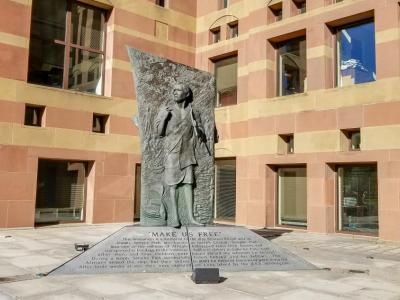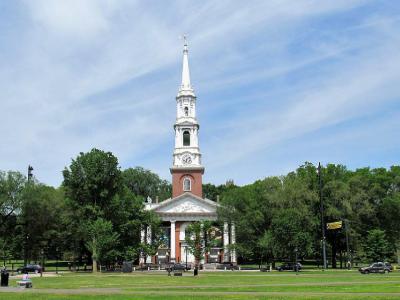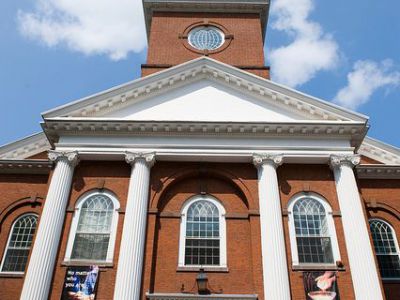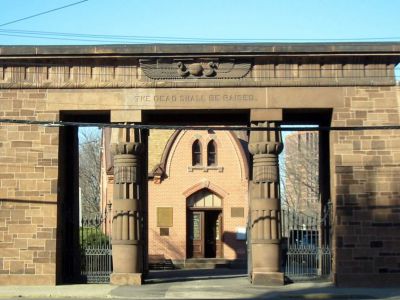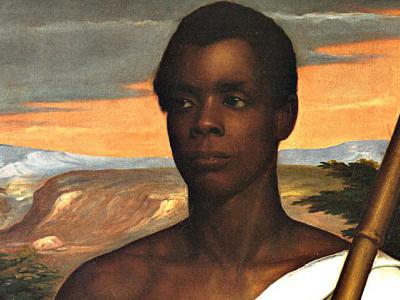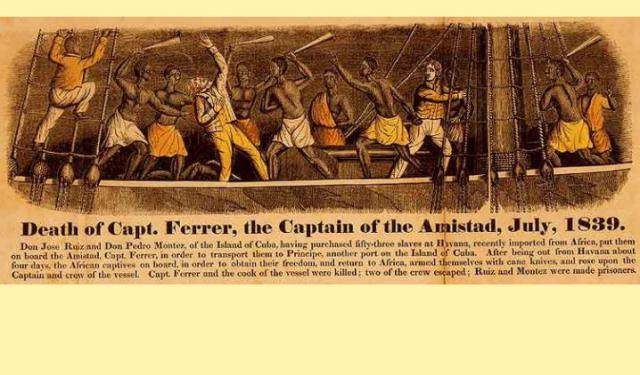
Amistad Freedom Trail (Self Guided), New Haven
The Cuban schooner La Amistad made history in July 1839 when a group of African captives on board unshackled themselves during the voyage, took control of the ship, and eventually landed on the US shore. The slaves responsible for the revolt were interned in New Haven, Connecticut to be tried for mutiny and murder. The case known as The United States vs The Amistad (1841) gained international publicity and was finally decided in favor of the Africans, restoring their freedom.
The Amistad Freedom Trail in New Haven, CT, begins at the Amistad Memorial, a powerful sculpture that commemorates the slaves who fought for their liberty. Their story unfolds at the Center Church on the Green, where the captives were held in the aftermath of the revolt.
Moving forward, the United Church on the Green bears witness to the courtroom drama that unfolded during the trial of the Amistad captives. Battell Chapel, another crucial site, marks a turning point in the fight for justice and the abolition of slavery.
The Grove Street Cemetery, a serene final resting place for many, holds the graves of individuals who played pivotal roles in the Amistad saga.
The Amistad history journey culminates at the New Haven Museum, where artifacts, documents, and exhibits further illuminate the Amistad story, allowing visitors to grasp the broader context and significance of this chapter in American history.
Ultimately, the Amistad Freedom Trail in New Haven is not just a historical tour but a poignant reminder of the enduring struggle for freedom and justice. As you embark on this self-guided tour, let the legacy of the Amistad captives inspire you to work towards a more equitable society wherever you live!
The Amistad Freedom Trail in New Haven, CT, begins at the Amistad Memorial, a powerful sculpture that commemorates the slaves who fought for their liberty. Their story unfolds at the Center Church on the Green, where the captives were held in the aftermath of the revolt.
Moving forward, the United Church on the Green bears witness to the courtroom drama that unfolded during the trial of the Amistad captives. Battell Chapel, another crucial site, marks a turning point in the fight for justice and the abolition of slavery.
The Grove Street Cemetery, a serene final resting place for many, holds the graves of individuals who played pivotal roles in the Amistad saga.
The Amistad history journey culminates at the New Haven Museum, where artifacts, documents, and exhibits further illuminate the Amistad story, allowing visitors to grasp the broader context and significance of this chapter in American history.
Ultimately, the Amistad Freedom Trail in New Haven is not just a historical tour but a poignant reminder of the enduring struggle for freedom and justice. As you embark on this self-guided tour, let the legacy of the Amistad captives inspire you to work towards a more equitable society wherever you live!
How it works: Download the app "GPSmyCity: Walks in 1K+ Cities" from Apple App Store or Google Play Store to your mobile phone or tablet. The app turns your mobile device into a personal tour guide and its built-in GPS navigation functions guide you from one tour stop to next. The app works offline, so no data plan is needed when traveling abroad.
Amistad Freedom Trail Map
Guide Name: Amistad Freedom Trail
Guide Location: USA » New Haven (See other walking tours in New Haven)
Guide Type: Self-guided Walking Tour (Sightseeing)
# of Attractions: 6
Tour Duration: 1 Hour(s)
Travel Distance: 1.8 Km or 1.1 Miles
Author: AudreyB
Sight(s) Featured in This Guide:
Guide Location: USA » New Haven (See other walking tours in New Haven)
Guide Type: Self-guided Walking Tour (Sightseeing)
# of Attractions: 6
Tour Duration: 1 Hour(s)
Travel Distance: 1.8 Km or 1.1 Miles
Author: AudreyB
Sight(s) Featured in This Guide:
- Amistad Memorial
- Center Church on the Green
- United Church on the Green
- Battell Chapel
- Grove Street Cemetery
- New Haven Museum
1) Amistad Memorial
The Amistad Memorial in New Haven is a powerful bronze sculpture by artist Ed Hamilton, commemorating the 1839 Amistad Affair—an iconic event in the fight for freedom and justice in the United States. Located directly in front of New Haven City Hall on Church Street, the memorial stands on the very spot where the 53 Mende captives from present-day Sierra Leone were jailed while awaiting trial for mutiny and murder.
The captives were kidnapped, shipped illegally to Cuba via the Tecora, and then placed on La Amistad. On July 2, 1839, Sengbe Pieh (Joseph Cinqué) led a revolt, but the ship was steered north and later seized off Long Island. Brought to New Haven, the captives faced trial in a landmark Supreme Court case. With community support and defense by John Quincy Adams, they were found to have acted in self-defense, won their freedom, and were welcomed into the New Haven community.
The memorial is structured with three sides showing Joseph Cinqué in different stages of his journey: in Africa, during his court trial, and as a free man. A fourth side, visible only from the upper floors of City Hall, shows a haunting image of a face and hands submerged in water—interpreted by scholar Laura Macaluso as a tribute to those who drowned in the Atlantic.
Hamilton used relief sculpture to bring these scenes to life, blending high relief for the prominent figures with low relief to include other captives and abolitionists, creating a multi-dimensional story carved in bronze. The Amistad Memorial is not just a historical marker—it’s a tribute to resilience, justice, and the enduring legacy of those who fought for freedom against overwhelming odds.
The captives were kidnapped, shipped illegally to Cuba via the Tecora, and then placed on La Amistad. On July 2, 1839, Sengbe Pieh (Joseph Cinqué) led a revolt, but the ship was steered north and later seized off Long Island. Brought to New Haven, the captives faced trial in a landmark Supreme Court case. With community support and defense by John Quincy Adams, they were found to have acted in self-defense, won their freedom, and were welcomed into the New Haven community.
The memorial is structured with three sides showing Joseph Cinqué in different stages of his journey: in Africa, during his court trial, and as a free man. A fourth side, visible only from the upper floors of City Hall, shows a haunting image of a face and hands submerged in water—interpreted by scholar Laura Macaluso as a tribute to those who drowned in the Atlantic.
Hamilton used relief sculpture to bring these scenes to life, blending high relief for the prominent figures with low relief to include other captives and abolitionists, creating a multi-dimensional story carved in bronze. The Amistad Memorial is not just a historical marker—it’s a tribute to resilience, justice, and the enduring legacy of those who fought for freedom against overwhelming odds.
2) Center Church on the Green
Nestled in the heart of New Haven, Center Church on the Green, officially known as The First Church of Christ, stands as a historic and architectural landmark. It is the center of the three iconic churches bordering the New Haven Green and traces its origins back to 1639 when it was founded by Puritan settlers who had arrived the year before to establish a theocratic colony they envisioned as a “New Jerusalem.”
The current church building, constructed between 1812 and 1814 during the War of 1812, is the fourth meeting house of the congregation. Designed by renowned New Haven architect Ithiel Town, the structure reflects the Post-Georgian or Federal style and was inspired by Saint Martin-in-the-Fields in London’s Trafalgar Square.
Beneath Center Church lies The Crypt, a rare intact colonial burial ground with over 1,000 remains and 137 gravestones dating from 1687 to 1812—the oldest belonging to Sarah Rutherford Trowbridge. The raised church floor hints at this hidden piece of early American history.
Inside, visitors find Waterford crystal chandeliers, Tiffany stained glass windows, and a Fisk Pipe Organ. A highlight is the central window by Joseph Lauber, depicting Reverend John Davenport’s first sermon on April 25, 1638, under an oak tree near today’s College and George Streets.
Center Church was central to early Connecticut life, with Congregationalism as the state religion until 1818. The 18th-century Great Awakening led to a split, forming the United Church to the north, while the Trinity Church was built to the south in 1814—placing the Center Church in the middle. It also shares historic ties with Yale: students worshipped here until 1757, commencements were held on-site until 1895, and seniors still circle the church on graduation day as its bells ring.
Today, Center Church continues to honor its rich past while embracing its role in the present, welcoming all who seek history, reflection, and community in the heart of New Haven.
*** Amistad Freedom Trail ***
Back in the mid-19th century, this church congregation was actively involved in supporting the Mende African captives during the Amistad incident and was particularly instrumental in gaining support for the Africans held in the New Haven Jail.
The current church building, constructed between 1812 and 1814 during the War of 1812, is the fourth meeting house of the congregation. Designed by renowned New Haven architect Ithiel Town, the structure reflects the Post-Georgian or Federal style and was inspired by Saint Martin-in-the-Fields in London’s Trafalgar Square.
Beneath Center Church lies The Crypt, a rare intact colonial burial ground with over 1,000 remains and 137 gravestones dating from 1687 to 1812—the oldest belonging to Sarah Rutherford Trowbridge. The raised church floor hints at this hidden piece of early American history.
Inside, visitors find Waterford crystal chandeliers, Tiffany stained glass windows, and a Fisk Pipe Organ. A highlight is the central window by Joseph Lauber, depicting Reverend John Davenport’s first sermon on April 25, 1638, under an oak tree near today’s College and George Streets.
Center Church was central to early Connecticut life, with Congregationalism as the state religion until 1818. The 18th-century Great Awakening led to a split, forming the United Church to the north, while the Trinity Church was built to the south in 1814—placing the Center Church in the middle. It also shares historic ties with Yale: students worshipped here until 1757, commencements were held on-site until 1895, and seniors still circle the church on graduation day as its bells ring.
Today, Center Church continues to honor its rich past while embracing its role in the present, welcoming all who seek history, reflection, and community in the heart of New Haven.
*** Amistad Freedom Trail ***
Back in the mid-19th century, this church congregation was actively involved in supporting the Mende African captives during the Amistad incident and was particularly instrumental in gaining support for the Africans held in the New Haven Jail.
3) United Church on the Green
Originally known as the North Church, the United Church on the Green is the third of the three New Haven Green Park churches. It was constructed in 1814 in a Federal style by architect David Hoadley. In 1884, it merged with Third Church to create a United Church.
The United Church on the Green features tall white columns in combination with brick walls, thus creating an impressive sight. The steeple of the church has served as a model for other church steeples in the U.S. Another prominent feature of this temple is a pipe organ.
*** Amistad Freedom Trail ***
Several members of both congregations were ardent abolitionists and played an active role in assisting New Haven’s free black community. Among them were the Reverend Samuel Dutton, Nathaniel and Simeon Jocelyn, who was one of the three founding members of the Amistad Committee formed to raise a defense for the Amistad captives, as well as Roger Sherman Baldwin, member of North Church and a New Haven attorney, who offered legal services to the Mende African captives. After the captives were freed, the Amistad Committee arranged for their return to Africa. Commemorating that event is a memorial plaque inside the church.
The United Church on the Green features tall white columns in combination with brick walls, thus creating an impressive sight. The steeple of the church has served as a model for other church steeples in the U.S. Another prominent feature of this temple is a pipe organ.
*** Amistad Freedom Trail ***
Several members of both congregations were ardent abolitionists and played an active role in assisting New Haven’s free black community. Among them were the Reverend Samuel Dutton, Nathaniel and Simeon Jocelyn, who was one of the three founding members of the Amistad Committee formed to raise a defense for the Amistad captives, as well as Roger Sherman Baldwin, member of North Church and a New Haven attorney, who offered legal services to the Mende African captives. After the captives were freed, the Amistad Committee arranged for their return to Africa. Commemorating that event is a memorial plaque inside the church.
4) Battell Chapel
Battell Chapel is the largest chapel of Yale University, located on the historic Old Campus in New Haven. Constructed between 1874 and 1876, it was primarily funded by Joseph Battell and other members of his family. Designed in the High Victorian Gothic style, the chapel features a striking exterior of rough brown New Jersey sandstone with decorative elements made of blue Ohio sandstone.
This building succeeded two earlier Yale chapels and served as the space for daily worship services, which were mandatory for all (male and mostly Protestant) Yale College students until 1926. Alongside Durfee Hall and Farnam Hall, Battell Chapel was part of a 19th-century initiative to define the perimeter of the Old Campus and create a stronger visual and structural separation from the rest of the city.
Inside, the chapel features a flat coffered ceiling made of wooden beams, painted blue and adorned with gold leaf. Solid oak paneling and pews line the interior, while religious symbols such as the Greek Cross and the Shield of the Trinity are displayed on the upper pier walls, reflecting Yale’s Congregational and Trinitarian heritage.
One of the chapel’s distinctive features is its now-silent clock and bell chime system, once a timekeeping reference for the entire university. The organ, gifted by Irene Battell Larned (Joseph Battell’s sister), and the Apse Memorial Windows—designed by architect Russell Sturgis and installed in 1876—honor Yale benefactors and its early leadership, including Elihu Yale and the university’s first nine presidents.
Today, Battell Chapel hosts University Church services and concerts by local ensembles, including youth and civic orchestras. It is also a recognized site on the Connecticut Freedom Trail, reflecting its cultural and historical importance.
*** Amistad Freedom Trail ***
The Chapel symbolizes the role the Yale Divinity School faculty and students played in helping the Mende Africans of La Amistad and houses a themed exhibition maintained by Yale.
This building succeeded two earlier Yale chapels and served as the space for daily worship services, which were mandatory for all (male and mostly Protestant) Yale College students until 1926. Alongside Durfee Hall and Farnam Hall, Battell Chapel was part of a 19th-century initiative to define the perimeter of the Old Campus and create a stronger visual and structural separation from the rest of the city.
Inside, the chapel features a flat coffered ceiling made of wooden beams, painted blue and adorned with gold leaf. Solid oak paneling and pews line the interior, while religious symbols such as the Greek Cross and the Shield of the Trinity are displayed on the upper pier walls, reflecting Yale’s Congregational and Trinitarian heritage.
One of the chapel’s distinctive features is its now-silent clock and bell chime system, once a timekeeping reference for the entire university. The organ, gifted by Irene Battell Larned (Joseph Battell’s sister), and the Apse Memorial Windows—designed by architect Russell Sturgis and installed in 1876—honor Yale benefactors and its early leadership, including Elihu Yale and the university’s first nine presidents.
Today, Battell Chapel hosts University Church services and concerts by local ensembles, including youth and civic orchestras. It is also a recognized site on the Connecticut Freedom Trail, reflecting its cultural and historical importance.
*** Amistad Freedom Trail ***
The Chapel symbolizes the role the Yale Divinity School faculty and students played in helping the Mende Africans of La Amistad and houses a themed exhibition maintained by Yale.
5) Grove Street Cemetery
Grove Street Cemetery is a historic cemetery located in the heart of New Haven, nestled within the Yale University campus. Established in 1796 and officially incorporated a year later, it was created to replace the overcrowded burial ground on the New Haven Green. It holds the distinction of being the first private, nonprofit cemetery in the world.
This cemetery marked a shift in burial practices, pioneering a thoughtfully planned layout with individually owned family plots, paved and named avenues, and ornamental plantings—features that helped redefine how society viewed death and burial. Historian Peter Dobkin Hall described it as a “real turning point” in the cultural treatment of death.
The cemetery owes its origins to a devastating yellow fever epidemic in 1794–95, which overwhelmed existing burial spaces. In response, Senator James Hillhouse and local families purchased land just north of Grove Street. The original 6-acre plot eventually expanded to 18 acres to accommodate demand. In 1821, monuments from the original New Haven Green burial site were transferred here.
One of Grove Street Cemetery’s most notable features is its Egyptian Revival gateway, completed in 1845. Designed by local architect Henry Austin and sculptor Hezekiah Augur—both of whom are buried there—the brownstone entrance bears the inscription “The Dead Shall Be Raised.” An 8-foot stone wall, added in the late 1840s, encloses the cemetery on three sides.
The site is the final resting place for many prominent figures, including 14 Yale University presidents, yet it was never an exclusive space and remained open to all. It reflects both the democratic and historical spirit of New Haven.
Grove Street Cemetery was added to the National Register of Historic Places in 1997 and designated a National Historic Landmark in 2000 for its historical and architectural significance. Today, it is maintained by Camco Cemetery Management and continues to be an important site of remembrance and heritage.
*** Amistad Freedom Trail ***
Among those interred here are the active members of the abolition movement, as well as those associated with African American history. A stone marker was dedicated by the Amistad Committee in September 2001 in remembrance of the six Mende African captives of La Amistad buried here.
This cemetery marked a shift in burial practices, pioneering a thoughtfully planned layout with individually owned family plots, paved and named avenues, and ornamental plantings—features that helped redefine how society viewed death and burial. Historian Peter Dobkin Hall described it as a “real turning point” in the cultural treatment of death.
The cemetery owes its origins to a devastating yellow fever epidemic in 1794–95, which overwhelmed existing burial spaces. In response, Senator James Hillhouse and local families purchased land just north of Grove Street. The original 6-acre plot eventually expanded to 18 acres to accommodate demand. In 1821, monuments from the original New Haven Green burial site were transferred here.
One of Grove Street Cemetery’s most notable features is its Egyptian Revival gateway, completed in 1845. Designed by local architect Henry Austin and sculptor Hezekiah Augur—both of whom are buried there—the brownstone entrance bears the inscription “The Dead Shall Be Raised.” An 8-foot stone wall, added in the late 1840s, encloses the cemetery on three sides.
The site is the final resting place for many prominent figures, including 14 Yale University presidents, yet it was never an exclusive space and remained open to all. It reflects both the democratic and historical spirit of New Haven.
Grove Street Cemetery was added to the National Register of Historic Places in 1997 and designated a National Historic Landmark in 2000 for its historical and architectural significance. Today, it is maintained by Camco Cemetery Management and continues to be an important site of remembrance and heritage.
*** Amistad Freedom Trail ***
Among those interred here are the active members of the abolition movement, as well as those associated with African American history. A stone marker was dedicated by the Amistad Committee in September 2001 in remembrance of the six Mende African captives of La Amistad buried here.
6) New Haven Museum
Founded in 1862 as the New Haven Colony Historical Society, the New Haven Museum is dedicated to preserving and sharing the rich history of the New Haven region. Housed in a 1929 Colonial Revival-style building designed by J. Frederick Kelly, the museum not only showcases the city’s evolution but also physically embodies its architectural heritage—incorporating artifacts from demolished local homes, including elements from the Nathan Smith and Benedict Arnold residences.
The museum features permanent and rotating exhibitions that explore topics such as the city of New Haven itself, the story of La Amistad, local decorative arts, and figures like Eli Whitney, Noah Webster, and Benedict Arnold. Other exhibits highlight institutions like Yale, the Winchester Repeating Arms Company, and natural landmarks like East Rock. The Ingersoll Room, furnished with 18th- and 19th-century pieces, offers a glimpse into domestic life in early New Haven.
In addition to exhibitions, the museum offers educational programs that promote interactive, inquiry-based learning, particularly focused on local history.
A major asset of the museum is the Whitney Research Library, a treasure trove for historians and genealogists. Its holdings span from the earliest days of New Haven’s settlement to the present and include over 300 manuscript collections, 4,000 architectural drawings, 75,000 photographs, and roughly 30,000 printed titles. Researchers also have access to vital statistics, genealogical materials, census records, and complete city directories from 1840 onward.
Through its exhibitions, collections, and archives, the New Haven Museum continues to serve as a vital link to the past, connecting generations to the dynamic story of the city and its people.
*** Amistad Freedom Trail ***
The Amistad Gallery within the Museum features, among other exhibits, a portrait of Joseph Cinque, leader of the Mende African revolt aboard La Amistad, painted by New Haven artist Nathaniel Jocelyn (1796-1881) in 1840. The gallery also features documents from the trial, including letters from John Quincy Adams and the Mende African captives.
The museum features permanent and rotating exhibitions that explore topics such as the city of New Haven itself, the story of La Amistad, local decorative arts, and figures like Eli Whitney, Noah Webster, and Benedict Arnold. Other exhibits highlight institutions like Yale, the Winchester Repeating Arms Company, and natural landmarks like East Rock. The Ingersoll Room, furnished with 18th- and 19th-century pieces, offers a glimpse into domestic life in early New Haven.
In addition to exhibitions, the museum offers educational programs that promote interactive, inquiry-based learning, particularly focused on local history.
A major asset of the museum is the Whitney Research Library, a treasure trove for historians and genealogists. Its holdings span from the earliest days of New Haven’s settlement to the present and include over 300 manuscript collections, 4,000 architectural drawings, 75,000 photographs, and roughly 30,000 printed titles. Researchers also have access to vital statistics, genealogical materials, census records, and complete city directories from 1840 onward.
Through its exhibitions, collections, and archives, the New Haven Museum continues to serve as a vital link to the past, connecting generations to the dynamic story of the city and its people.
*** Amistad Freedom Trail ***
The Amistad Gallery within the Museum features, among other exhibits, a portrait of Joseph Cinque, leader of the Mende African revolt aboard La Amistad, painted by New Haven artist Nathaniel Jocelyn (1796-1881) in 1840. The gallery also features documents from the trial, including letters from John Quincy Adams and the Mende African captives.
Walking Tours in New Haven, Connecticut
Create Your Own Walk in New Haven
Creating your own self-guided walk in New Haven is easy and fun. Choose the city attractions that you want to see and a walk route map will be created just for you. You can even set your hotel as the start point of the walk.
Yale University Walking Tour
Perhaps the main attraction that puts the picturesque town of New Haven, Connecticut, on the international tourist map is Yale University. Founded in 1701, this esteemed educational institution ranks among the oldest and most prestigious in the United States.
In addition to its academic excellence, and because of its age, Yale boasts a great deal of architectural beauty. A diverse range of... view more
Tour Duration: 1 Hour(s)
Travel Distance: 1.4 Km or 0.9 Miles
In addition to its academic excellence, and because of its age, Yale boasts a great deal of architectural beauty. A diverse range of... view more
Tour Duration: 1 Hour(s)
Travel Distance: 1.4 Km or 0.9 Miles
New Haven's Historical Buildings Tour
The first ever planned city in the United States, New Haven, Connecticut, is famous for a wealth of prominent homes that have stood the test of time.
Some of these buildings, like the Caroline Nicoll House, showcase the elegant symmetry and refined detailing befitting Federal style. Others, like the John Cook House, represent a prime example of the Greek Revival architecture, characterized by... view more
Tour Duration: 2 Hour(s)
Travel Distance: 2.9 Km or 1.8 Miles
Some of these buildings, like the Caroline Nicoll House, showcase the elegant symmetry and refined detailing befitting Federal style. Others, like the John Cook House, represent a prime example of the Greek Revival architecture, characterized by... view more
Tour Duration: 2 Hour(s)
Travel Distance: 2.9 Km or 1.8 Miles
New Haven Introduction Walking Tour
New Haven, Connecticut is widely known as the home to Yale University. However, the city isn't just a hip, university town. It is also full of history and sites that can't be found anywhere else.
The first planned city in the United States, New Haven boasts the easily maneuvered grid layout which makes it easy to navigate the city on foot. Situated at the center of this grid, New... view more
Tour Duration: 2 Hour(s)
Travel Distance: 2.1 Km or 1.3 Miles
The first planned city in the United States, New Haven boasts the easily maneuvered grid layout which makes it easy to navigate the city on foot. Situated at the center of this grid, New... view more
Tour Duration: 2 Hour(s)
Travel Distance: 2.1 Km or 1.3 Miles
The Most Popular Cities
/ view all
